By Amanda Durish Cook
MISO and SPP are ready to reform their interregional planning process to improve their shot at producing their first cross-border transmission project, but they plan to wait a year before launching a joint study to identify such a project, the RTOs said Tuesday.
At a Feb. 27 MISO-SPP Interregional Planning Stakeholder Advisory Committee (IPSAC) meeting, the RTOs admitted that criteria spelled out in their joint operating agreement might be preventing beneficial interregional projects from gaining approval. They said they are ready to work with stakeholders through the summer to ease some restrictions.
SPP Interregional Coordinator Adam Bell said the RTOs’ latest coordinated system plan study, concluded in 2017, showed they are still inconsistent in how they calculate adjusted production costs, develop regional models and review regional project proposals. Before being approved, proposed interregional projects must clear separate regional reviews by each RTO in addition to passing a joint review.
The RTOs have failed to approve an interregional project despite having conducted two coordinated system plan studies, although they have examined several candidate projects. (See MISO Confident in Tx Process with SPP Despite Lack of Projects.)
“We’ve learned a lot in both coordinated plans we’ve done,” Bell said. “Both SPP and MISO are interested in doing meaningful planning between our systems, and we want stakeholders to have faith in the process and feel good entering these studies. … Both RTOs support … designing a new study process that has stakeholder confidence. We’ve done this twice. Let’s fix this thing.”
Davey Lopez, MISO adviser of planning coordination and strategy, said the RTOs plan to collect stakeholder suggestions and do more research before returning to the IPSAC in May with recommendations on how to improve their joint planning. The RTOs plan to work with stakeholders through September to prepare a FERC filing to alter their JOA by the end of the year.
Comprising planning staff from both RTOs, the Joint Planning Committee will vote later this year on whether to pursue another coordinated system plan.
Staff from both RTOs cautioned that they were unlikely to develop a 2018/19 study because planners are inclined to concentrate fully on process improvements, but stakeholders will be provided a non-binding IPSAC vote on where planners should concentrate their efforts.
$5 Million Obstacle
SPP and MISO said a major piece of the overhaul would be lowering the RTOs’ $5 million cost threshold for interregional projects.
“Hopefully, we can remove some of these hurdles on the coordinated system plan,” Lopez said.
In response to a question by Entergy’s Yarrow Etheredge, MISO and SPP staff declined to identify any specific project they would have liked to see pass but for the RTOs’ stringent criteria, although Lopez noted a few instances in which lowering the $5 million threshold would have improved a project’s chances in the last coordinated system plan.
“We really finished one study and started another, so we didn’t have time to implement these improvements we identified,” Bell said, referring to the short gap between the 2014/15 and 2016/17 studies. At the time, MISO recommended awaiting a second coordinated study while the RTOs worked out differences between their planning processes, but MISO eventually abandoned the idea in favor of starting another study.
Bell said it’s imperative for the RTOs to align their adjusted production costs and more accurately model each other’s systems. He suggested removing MISO and SPP’s joint modeling efforts altogether in favor of working on more identical regional models. Several stakeholders objected to that idea, claiming it could complicate cost allocation between the RTOs. Bell pointed out that MISO and SPP would still have a joint study under his plan, just not a joint model.
The RTOs are additionally contemplating allowing for adjustments in modeling cost allocation to determine if the benefits of a project are amplified.
SPP also continues to support cost allocation for sub-345-kV interregional projects with MISO, Bell said, a subject that MISO continues to discuss, according to Lopez. MISO has proposed cost allocation changes for its market efficiency projects, including a sub-345-kV cost allocation and elimination of a footprint-wide postage stamp rate. (See MISO Recommends Cost-Sharing for Sub-345 kV Tx.)
Entergy Critical of MISO-SPP TMEP
Entergy engineer Kyle Watson said the MISO-SPP seam does not yet have a structured enough coordination process to develop smaller interregional projects, such as those eligible to qualify under the new MISO-PJM targeted market efficiency project (TMEP) category, which relies on historical congestion to identify small transmission projects. MISO and PJM approved a $20 million, five-project TMEP portfolio late last year, representing the first interregional transmission projects between the two RTOs, and some stakeholders have called for a similar process on the MISO-SPP seam. (See MISO Board Approves $2.6B Transmission Spending Package.)
Entergy’s Matt Brown said there isn’t sufficient operational data since the integration of the company into MISO and the Western Area Power Administration into SPP to build a case for congestion-relieving projects. But SPP Director of Seams and Market Design David Kelley disagreed, saying MISO and SPP have already collected enough historical congestion data to justify projects that are less costly than continuing to pay market-to-market congestion charges.
“The day-ahead and real-time congestion is persisting,” agreed Lopez.
During the IPSAC meeting, the RTOs pointed out that one congested flowgate on the Oklahoma-Kansas border has been responsible for nearly $20 million M2M payments since February 2017.
Wind on the Wires’ Natalie McIntire and WPPI Energy’s Steve Leovy said their organizations are displeased that the RTOs are not inclined to begin another coordinated system plan this year, given that the 2016/17 plan focused narrowly on needs along SPP’s Integrated System in North Dakota, South Dakota and Iowa, and the larger SPP-MISO seam has areas of congestion.
“There’s a lot of consumers bearing costs because we’re not fixing these issues,” Leovy said. “There’s need for a major interregional study.”
“We’re not happy, but we recognize there’s general consensus beyond us,” McIntire said.








